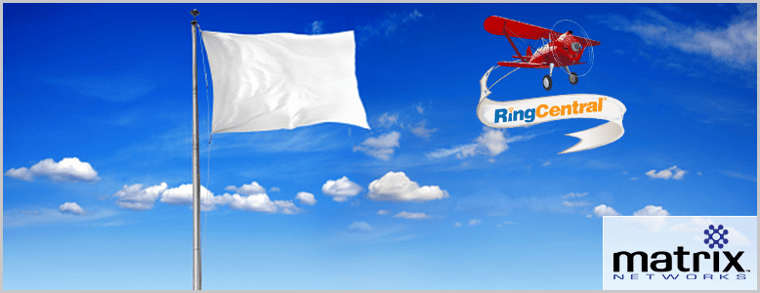
The tides of telecom are shifting again. For nearly a decade, countless suppliers have chased the dream of being a leading solution in cloud-based communications, also known as Unified Communications as a Service (UCaaS). Each supplier delivers their own “unique solution” some built from within, some disguised as “unique,” with Cisco-owned BroadSoft as a backend. All touting the ubiquitous benefits of always up-to-date features, ultimate flexibility, and headache-free Op-Ex maintenance. For those born in the cloud (RingCentral, Zoom, 8x8, etc.) the path to achieving this goal has been much more achievable than those that came from the hardware-intensive on-site products of days past.
The writing is on the wall as yet another industry giant throws up the metaphorical white flag and partners with the industry leader rather than developing their own solution (not for lack of trying…). Avaya and Mitel represent two of the largest installed bases of business phones on the face of the planet – and BOTH have selected RingCentral as their partner to achieve what each was unable to accomplish themselves. Why did Avaya fail? Why did Mitel fail? What does this mean for the millions of customers that rely on their solutions every day to keep business moving? And why did both choose RingCentral?
Avaya and Mitel Choose RingCentral
Avaya represents America’s largest install base, with over 120,000 individual organizations leveraging their technology for daily communications. Mitel is one of the last remaining original suppliers dating back to a founding date of 1973. Mitel boasts a user base of over 70 million users in 100 countries. Both are incredibly impressive companies that have stood the test of time and left major imprints on the world of telecommunications. BUT… Neither could crack the code of developing and delivering a successful cloud migration strategy. With aging premise-based equipment and increasing value in cloud-based communication solutions, developing a cloud phone solution to migrate their customer bases meant survival. So, what went wrong?
For Avaya, the equation is not complex. Avaya's attempts at creating a multi-tenant cloud solution were never very successful. Their solution was simply put, their traditional PBX in a data center and…TADA CLOUD! Apparently, they missed the memo about product development, client experience, and ease of use/deployment. The partnership between RingCentral and Avaya benefits Avaya because it gives them a revenue stream that would have evaporated otherwise since no viable solution was ever produced internally. Good job Avaya! For more on the RingCentral and Avaya Partnership click here.
The Mitel story, however, is far more complex. Where Avaya never really tried, Mitel has had several attempts at bat and stuck out each time. Mitel’s first dabbled in the cloud is like Avaya’s: placing their equipment in data centers and charging a subscription cost. Later they acquired ShoreTel in 2017 another company further along in the transition to cloud, first purchasing a fledgling cloud communications provider F5 and then developing their own ShoreTel Connect. Before the Mitel acquisition, ShoreTel set a new bar for IP phone systems technology, being touted as “built on a clean sheet of paper”. If you were in IT in the mid-2010s, you probably remember this marketing phrase. Essentially it meant that ShoreTel’s IP telephony solution was developed and brought to market without the constraints of legacy digital phone systems (coupled with the internal corporate conflict that comes with it). ShoreTel’s status as a new pure IP phone system surely left them primed and ready to take the cloud-based phone system industry by storm. However, at the time of Mitel’s acquisition, the product had degraded to a shell of its once great self. This was because ShoreTel was in the middle of massive cuts to R&D, leadership personnel and support staff to decrease overhead cost and position for sale (another blog post unto itself). Regardless of circumstances, when Mitel acquired ShoreTel, the bones of what made ShoreTel a great fit for cloud were still in place, all Mitel had to do was put the pieces back together and capitalize on the momentum. So how did Mitel fail to capitalize? The answer is unclear to this author. What is clear is that the partnership with RingCentral suggests that Mitel has finally realized they are unable to achieve the goal of delivering a viable cloud communication solution. The white flag has been flown. What does this mean for the 70,000,000 Mitel users that rely on their solution every day? In short: hooray!
What to Expect if you are a Mitel Customer
What we have seen with the partnership between Avaya and RingCentral is what we expect to see from Mitel and RingCentral. In the case of Avaya, marketing came up with the name Avaya Office Cloud or ACO powered by RingCentral. All this means is that you can now migrate your Avaya Phone System to RingCentral and in many cases, do not need to replace your handsets. Avaya is simply allowing the RingCentral software to work on their endpoints where before they had no reason to. Why let the enemy leverage their proprietary technology? Handsets are just SIP endpoints on the network, many folks are already using softphones with headsets these days for much of their communications, all that was needed is for someone to unlock the door. This partnership allows just that. Cool right? We hope this is the case with Mitel as many of Matrix Networks clients will be able to migrate to a reliable cloud-based solution without the need for investment in expensive handsets. In addition, Mitel is allowing existing customers of their MiConnect Cloud platform to migrate to RingCentral prior to contract end without penalty!
What else changes? Most likely, nothing… Everything else stays the same as it was before the partnership. You should be in the cloud for your communication tools. You deserve the flexibility and feature-rich platforms that come with modern technology. You should be investing in the very best the industry has to offer and that very best is RingCentral.
Why RingCentral?
As a 7-time award winning and Gartner’s Magic Quadrant Leader in Unified Communications, RingCentral still stands at the top of the UC pyramid. It goes without saying that choosing RingCentral amongst the competition was probably not the most difficult decision Mitel ever made. The harder solution, undoubtedly, was to throw up the white flag. However, in this case admitting defeat, does not mean surrender. In fact, admitting defeat gives Mitel a new lease on life. With hundreds of Mitel Clients across the country, Matrix Networks could not be more exited for this partnership. For years, Matrix has been waiting for the right Mitel solution to confidently deliver a clear path to the cloud. This partnership gives us, and many like Matrix, that path.
In closing, Matrix Networks has over 37 years' experience deploying Mitel technology, and over 15 years’ experience supporting ShoreTel solutions. Two years ago, Matrix Networks became the Pacific Northwest’s first RingCentral Premier Partner. One of only 15 in the world at that time. We believe in the solution for many reasons, one being, RingCentral’s relentless drive for continuous improvement, investing more dollars in Research and Development than any other supplier in the UCaaS industry. Another reason being RinCentral’s time tested reliability. Most importantly however, is that Matrix Networks strives to deliver the very best technology possible to our clients. At the end of the day, we suspect, this is the same reason Mitel (and Avaya) have chosen to do the same.
Author: Ryan Graven



.svg%20(1).png?width=55&name=1200px-Logo_of_YouTube_(2015-2017).svg%20(1).png)

